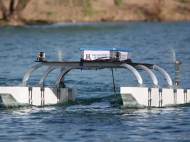TEX II – robotic planetary lake lander
 A researcher from the University of Arizona has developed Tucson Explorer II (TEX II) – an autonomous robotic lake lander that could potentially be used to explore the lakes of liquid hydrocarbon known to exist on Saturn’s largest moon named Titan. The robot could be used in terrestrial applications such as search and rescue missions in oceans, lakes, and hazardous environments, as well as for environmental research projects.
A researcher from the University of Arizona has developed Tucson Explorer II (TEX II) – an autonomous robotic lake lander that could potentially be used to explore the lakes of liquid hydrocarbon known to exist on Saturn’s largest moon named Titan. The robot could be used in terrestrial applications such as search and rescue missions in oceans, lakes, and hazardous environments, as well as for environmental research projects.
“TEX II is ready to deploy on missions related to defense and security, such as harbor surveillance and cleanup operations of littoral munitions dumps and mines”, said its developer Wolfgang Fink, who is an associate professor in the UA department of electrical and computer engineering and the department of biomedical engineering. “Another potential application of this lander is oceanographic research into currents and marine pollution.”
Fink presented TEX II as an autonomous exploration vehicle that TEX II is the second vehicle designed by Fink as part of his NASA-award-winning concept of future planetary exploration, which he calls “tier-scalable reconnaissance”. Fink envisions future planetary research being conducted by a hierarchy of intelligent, autonomous robots that could include satellites, airships or blimps, and a fleet of rovers and lake landers.
TEX II is highly modular and portable and was designed as a catamaran for enhanced stability and to allow the various onboard sensors easy access to the surface and subsurface of the water, or other liquid, upon which it is deployed. It weighs about 45 kg (100 pounds) and its central raised deck can carry a 68-kilogram (150-pound) payload of computers, batteries and sensors. The twin hulls are each 1.82 meters (6 feet) long and set about 1.5 meters (5 feet) apart.
Aside sustaining hull damage without jeopardizing buoyancy, the shallow draft of the fortified Styrofoam hulls decrease perturbation in the water around TEX II and increase performance by minimizing interference with subsurface telemetry from the onboard sensors. Although suitable for terrestrial use, the researchers might have to come up with different solutions for use in other liquids that might damage Styrofoam in case of hull damage.
Like planetary rovers he previously developed, the current configuration of TEX II can be controlled from anywhere in the world via an Internet connection and there’s an effort to make it fully autonomous. Air-propellers mounted at the back of each hull are powered by electric motors that can switch rotational direction to drive TEX II backward or forward. Aside increased maneuverability, this way of propulsion enables the robot to pivot in position. The propellers are set as far apart as possible so they deliver maximum torque to the chassis during turning, and the top speed depends on the size of the installed motors.
TEX II is currently fitted with onboard cameras and sonar that can penetrate up to 100 meters (330 feet). According to Fink, the robot could easily be equipped with additional sensors in order to detect pathogens, toxins, explosives, radiation, and so on. The entire chassis and sensor deck can be decoupled from the catamaran hulls and attached to an alternative propulsion system.
For more information, read the paper published in IEEE Aerospace Conference Proceedings: “Robotic Lake Lander Test Bed for Autonomous Surface and Subsurface Exploration of Titan Lakes“.









Leave your response!